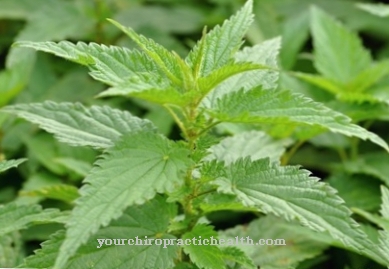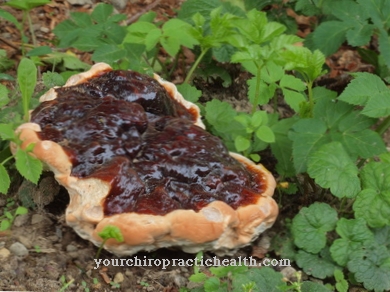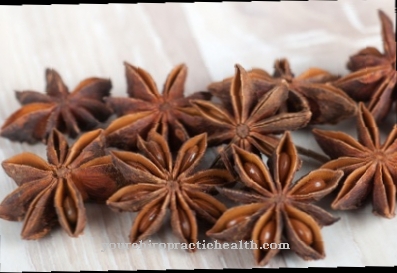Sea buckthorn is a deciduous plant of the Elaeagnaceae family that is widespread in Europe and Asia. The bushes, which are usually 1-6 meters high, prefer sandy soil and require full sunlight.
Occurrence & cultivation of sea buckthorn

The common one Sea buckthorn is the most widespread species of the genus, which grows in Western Europe mainly on the sea coasts enriched by the salt mist.
More than 90 percent of the world's commercial sea buckthorn plantations are now in China, where the plant was initially established for purposes of erosion and water protection. The silvery-green lanceolate leaves are arranged close to the thorn-studded branches.
Only the female sea buckthorn plants produce the characteristic orange-colored, 6-9 mm large, elongated-oval berries that are juicy and rich in oils. The rapidly expanding roots of the sea buckthorn plant enrich the soil with nitrogen.
Application & use
The harvest and processing of Sea buckthorn is very complex due to the thorny vegetation and is mostly done by machine. In the recycling process, the berry components are mainly separated in order to filter the main products juice, dried fruits, nutrient extracts and oil.
The residues are processed as valuable feed. The fruits of the sea buckthorn are rich in vitamin C, vitamin E and other nutrients such as flavonoids. The oil mainly contains essential fatty acids.
Even the leaves can be used to make tea because they contain antimicrobial triterpenes. Leaves and twigs are also a source of vegetable protein (11-22%).
100 grams of fresh sea buckthorn berries contain on average:
- 600 mg vitamin C (lemon 51 mg)
- up to 180 mg of vitamin E.
- up to 80 mcg of folic acid
- 30-40 mg of carotenoids, including beta-carotene, lycopene, zeaxanthin
- 3-5% unsaturated and saturated fatty acids in the pulp and 8-18% in the seeds
- other organic acids such as quinic acid or malic acid
- 100 - 1,000 mg of flavonoids (e.g. isorhamnetin, querceting glycosides and kaempferol) in a composition similar to that of ginkgo biloba
Flavonoids and oils from sea buckthorn are the preferred ingredients extracted for medicinal use. Flavonoid extracts usually contain 80% flavonoids and 20% residual oils, vitamin C and other ingredients. When processing sea buckthorn oil, the unsaturated fatty acids are of great interest; the extracted oils therefore hardly contain any flavonoids or vitamin C.
Sea buckthorn juice and fruit pulp are also refined and can be found in stores as diluted fruit juices, syrups, jams, liqueurs or candies. The rich ingredients of the sea buckthorn are also used for the manufacture of cosmetic products (e.g. anti-aging creams) and dietary supplements.
Significance for health, treatment & prevention
Sea buckthorn Due to its high content of flavonoids and vitamin C, it has a strong antioxidant effect, which is used for the following areas of application:
- Cancer therapy
- long-term therapy to reduce cardiovascular risk factors
- Treatment of gastrointestinal ulcers
- internal and topical therapy for a wide variety of skin conditions
- Use as liver preparation (detoxification) and remedy for cirrhosis of the liver
Sea buckthorn is mainly used in the medical field in Asia. However, as there are hardly any clinical studies in Europe, sea buckthorn is currently still part of the field of folk medicine. In the context of Chinese studies, for example, a sea buckthorn preparation was successfully injected into the bone marrow of cancer patients to protect it from radiation damage.
At the same time, the extract is able to promote a faster recovery of the bone marrow cells. The use of sea buckthorn in cardiovascular diseases lowers cholesterol and improves heart functions, as well as the risk of developing angina pectoris. Flavonoids extracted from sea buckthorn are also able to reduce pathogenic thromboses.
An active ingredient combination of sea buckthorn flavonoids, safflower oil and liquorice (Ai Xin Bao) is now used in the treatment of coronary heart disease and the effects of a heart attack or stroke to improve blood flow and restore heart functions.
When used on the stomach and liver, sea buckthorn kernel oil has an anti-inflammatory and normalizing effect. The nourishing palmitoleic acid contained in the oil has a healing effect in the treatment of burns and open wounds as well as systemic skin diseases such as neurodermatitis. The UV-blocking activity of sea buckthorn is used as an ingredient in sun creams.




























